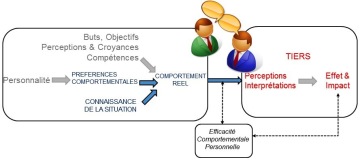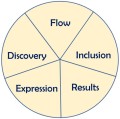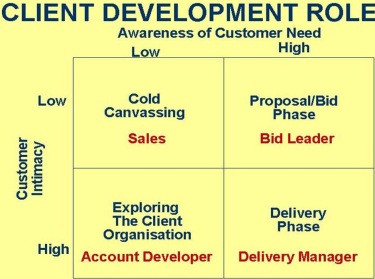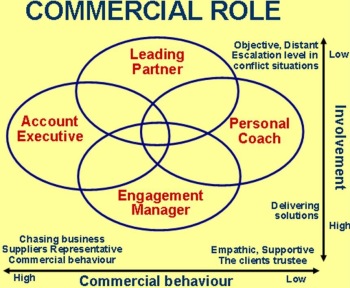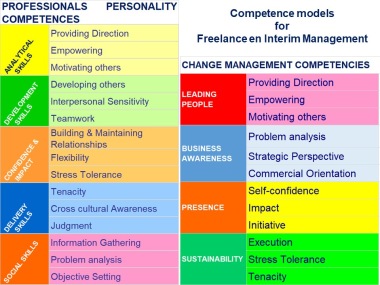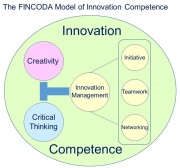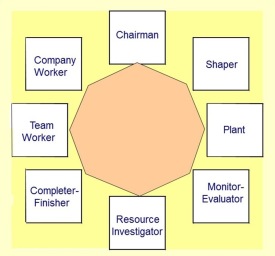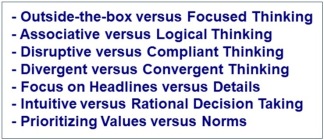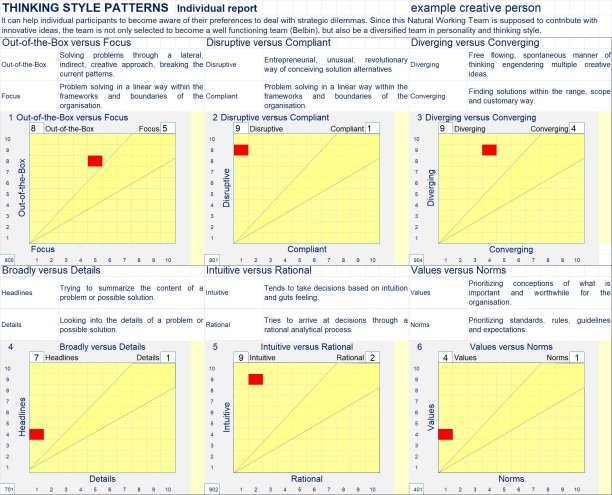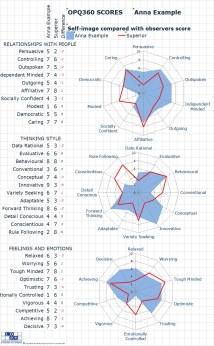LDT-BASED CARREER COUNSELLING (LCC)
- THE PROCESS
- THE PROCESS
I GETTING ACQUAINTED AND STARTING UP
During the first review the dialogue concerns your background and experience, your development need and ambitions. And we will make decisions about the steps of the process and what you may expect from this.
Between step I and II
After the first meeting, you will, via the LDpe website, complete a personality questionnaire, which will take you about 20-30 minutes.
By your answers to the questionnaire, we will get an inventory of your behavioural preferences. The resulting personality profile will be the input to the LDT.
Unless your organisation uses another standard, we will use the OPQ (Occupational Personality Questionnaire) for this.
The OPQ-profile covers 32 personality dimensions.
This profile will be discussed as the primary topic in step II.
II PERSONAL LEADERSHIP
With this step, you entered a development program that helps you to become ‘Master of Your Own Destiny’ and accelerate your personal development. You will discover what type of activities really fire you up, how you more effectively interact with the people around you and how you will be able to consciously develop yourself.
You will receive your personal reports out of the hands of a certified reviewer, who will coach you and will explain the content, theories and models, and who will answer any of your questions, belong to you and they will not be revealed to any other person except yourself, without your explicitly expressed consent.
The reports will be produced with the help of LDpe’s Leadership Development Toolbox (LDT).
More than 3000 leaders and professional around the world have already participated in LDT-based development programs.
This step, which also can be taken as a separate complete program (the Step-Up Personal Leadership Programme) will probably be the start of a stimulating personal development process, in which you will learn to focus on who you are, how you wish to develop yourself, find your direction and consequently take your actions.
In LDpe’s programs we make use of the most actual scientific findings, as well as the most applicable and recognised theories, concepts and models. In good co-operation with the authors, LDpe connects the LDT to their pioneering publications.
A. PERSONALITY PROFILE.
The measurement with the OPQ personality questionnaire
Learn about your Core Qualities and
Improve your Behavioural Effectiveness
Improve your Behavioural Effectiveness
After having studied the OPQ-profile, the outcome of your answers to the personality questionnaire, we will introduce Daniel Ofman’s Core Quality concept, an easy way of learning about your personal behavioural effectiveness.
Everyone has core qualities as a consequence of his behavioural preferences. Often, these core qualities are hardly visible to us ourselves. They come so naturally that we really don’t register them as special traits. Yet, knowing your core qualities offers great insight into your pitfalls, challenges and allergies as well. Daniel Ofman’s Core Qualities Quadrant Methodology, Daniel Ofman helps us to recognize them. This of course is highly valuable when you interact with other people.
When you understand the core quadrant of your core quality, it is much clearer why you respond to others the way you do.
B. CHECKLIST POTENTIAL QUALITIES AND POSSIBLE PITFALLS
LDT produces a checklist on potential qualities and possible pitfalls, related to the behavioural preference. The checklist supports the participant in a deeper reflection about his personal behavioural effectiveness.
And the Combination List shows when combinations of different lower and higher scores may indicate something specific and tells us how others may perceive your behaviour.
The insights on potential qualities and possible pitfalls of one's behaviour is very useful. But, the main thing, of course, is what the effect of one's behaviour is on others: how they perceive and interpret the behaviour and what it brings about in them.
Especially for leaders this insight is essential since the key of leadership is to achieve results through others.
C. REPORT CONSCIOUS EFFECTFUL INTERACTION COMPETENCES
This report analyses your competences to effectful interact with others, by taking notice of how your behaviour affects them, how they may perceive and interpret your behaviour and how they may respond to it.
Your development journey starts with identifying
your Motivational Flames
your Motivational Flames
D. MOTIVATIONAL FLAMES REPORT
The most important, if you wish to develop yourself is your motivation.
‘Motivation matters more than Talent’ says Sophie Bennett, the author of ‘Find Your Flame’. Her research led to 5 flames of Motivation:
Flow, Inclusion, Results, Expression and Discovery.
In the Motivational Flames Report we show you the scores of your Flames and how they will evolve if you follow the simulation scenarios.
Develop your CEO-brain
E. EXECUTIVE COMPETENCES
The key to your self-development lies in your executive brain, the part of your brains that is busy with your ability to adopt to changes, making plans, learn from feedback, outside-the-box thinking, developing a vision, making complex decisions, pro-social behaviour, feeling motivated and the ability to control your emotions and suppress ineffective behaviour. The executive brain, also named the CEO-brain, is located in the prefrontal cortex.
For realising your goals three things are fundamental:
1 Formulating and Monitoring
You must know the goals you aspire to realise, keep these goals in mind and monitor how far you are from fulfilling your objectives.
2 Motivation
You must be motivated enough to put plenty of energy in realising your goals.
3 The right capabilities
You must have the right competences available, to set out and walk the path, and to cope with all obstacles and seductions you will encounter on your way.
The LDT gives you insight in your scores on the so-called Executive Competences and shows the positive impact of the simulation scenarios.
The LDT Simulation Module
F. SIMULATION SCENARIOS
The LDT Simulation Module helps you to see what happens if you change some of your behavioural preferences. In fact, you may consciously change your preferences in order to develop a stronger profile that enables you to handle a larger variety of situations. By testing the impact of changes, LDpe sets up a proposal with simulation scenarios. This may help you in your development plans.
Between step II and III
Besides the reflections about the provided information from this step (behavioural traits, personal behavioural effectiveness, qualities, pitfalls, motivational flames and executive competences), the LDT360 process will, if applicable, start up.
With the help of the LDT360 module, you will be able to invite others to give their opinion about how they perceive you.
If you have chosen to abstain from the LDT360 process, steps VI and VII will be obsolete.
III COMPETENCES AND STYLES
In the Program Competences and Styles, we will find out how your behavioural preferences give us an indication about your competences - your ability to perform certain tasks - and about your style portfolio. We also analyse the effects of the earlier proposed simulation scenario's on competences and styles.
Competences as building blocks in the development of the LDT
The inducement for developing the LDT, back in 2001, was our quest: 'Why is the information from a personality assessment mainly meant for others (psychologist, recruiter, HR-professional, coach) than the participant him/herself? When using the LDT, we explicitly want to see the participant as the engine for the development process. The objective of the LDT is to provide the participant with a systematic means for self-reflection and self-development within a coherent framework of conceptions.
The LDT helps participants to find their path to more effective behaviour, to the extension of their personal style portfolio and to the acceleration of their personal development. A prime requirement in the development of the LDT, therefore, was to establish a bridge between the domains of psychotechnics and leadership.
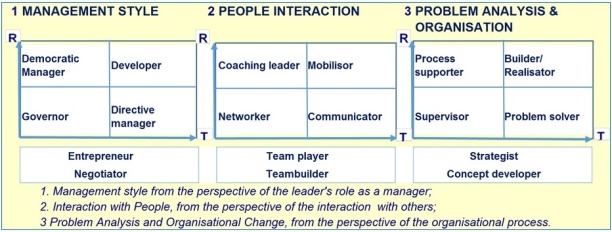
We defined the LDT leadership model, based on the most well-known leadership models and identified a number of styles. These leadership styles and also the later defined worker styles and professional roles were to be connected to the assessment scores. We decided to connect the styles and roles indirect, via the competence scores. Every competence - the ability to perform a certain task - is connected to several preferences.
The concept of ‘competence' and the competence mode
The term 'competence', in relation to personality measurement, was used since the 1970s. In the 1990s activities as competence-analyses and competence-management were hyped. Defining competence models and managing competences became a popular activity for consultants and HR-experts. Self-respecting organisation developed its own competence model with the intention to develop the staff in the direction of the defined mission. The chaos became complete. Today we still see different notions and types of competence models. LDpe defines 'competence' as 'an obtained capability to adequately perform a task, role or mission’.
The requirements in the development of the toolbox were to use a 'clean' and common applicable set of competences that could be connected with measured personality dimensions. LDpe chose the competence-model developed by the Dutch organisation Psychoteckniek, now part of SHL, the owner of the OPQ.
G. DASHBOARD COMPETENCES AND STYLES
How the scores of your behavioural preferences translate to competences, stressors, leadership styles and worker styles.
H. COMPETENCE REPORT
The LDT delivers detailed information about the participant’s competences. This information can be used for analysis and reflection about the own qualities.
A competence is an obtained capability to perform a task, role or mission’. Competences have a fixed relation to several behavioural preferences. Every style (Leadership Style, Worker Style) is related to a fixed number of competences.
I. STRESSORS REPORT
The Stressor profile provides indications on the participant's possible stressors and the individuals sensitivities to stress, particularly in the working environment.
These indications can be used in individual counselling. But the participant may also learn to recognize the own stress pattern and reflect about a possible coping strategy.
J and K. LEADERSHIP STYLE REPORT AN WORKER STYLE REPORT
The participant gets information about how your style portfolio relates to competences and behavioural traits. With this information he can analyse how a broader style portfolio may be developed.
Between III and IV
You will, at this stage have an abundant amount of reports at your disposal, about the current state of competences, stressors and styles and the relation of these with your behavioural preferences. Information that will permit you to analyse the consequences of this.
Such an analysis will have made you aware of the own behaviour and the fact that conscious adjustments of your behavioural preferences may lead to an improved behavioural effectiveness and growth of your style portfolio.
IV PROFESSIONAL ROLES
Leadership is not limited to roles in giving direction to and supporting the employees of an organisation. Leadership is also needed for the development of a new market, a large account, the acquisition of a major contract, to deliver this contract or to lead the change of an organisation. Such roles, we will call them 'Professional roles', ask for specific combinations of leadership qualities
But even the domains of Business Development, Sales or Change Management are so extensive that a 'professional leader' will not be as good in all aspect of the field. Therefore, most of the professional development programs start to create a dedicated language for the specific field they cover, for instance client development, commercial roles or program management. Unlike the widely accepted leadership theories we referred to above, most of the theories in the fields of Business Development & Sales and Change Management, Program Management and Project Management are based on specific methodologies, and not widely accepted outside the scope of this methodology.
LDpe has witnessed the need for a consequent more generalised language, primarily based on the talents and personality of the professional leader. Therefore, LDpe has developed several concepts enabling leaders to analyse which part of a specific role they are good at and how they (by following the simulation scenarios) can improve their qualities to play the different roles.
Below we explain the different roles in the models for Client Development, Commercial Roles and Program Management Roles. For these roles you will find your 'fit-for-role' score. And we have calculated with the simulation module how you will be able to improve these scores when following the simulation scenarios.
Concepts and models for Business Development and Acquisition
The first model in the field of Business Development and Acquisition refers to the (professional) leader's client development role. This model is especially created for account managers.
Not every situation is the same when developing the relationship with 'an account'. In a new relationship, customer intimacy is still low and growing the relationship is one of the objectives for the account manager. In 'sales' terminology we speak of 'hunters' (for new clients) and 'farmers' (those who have an enduring relationship with the client organisation).
The second model in business development & acquisition relates to the distribution of roles when the clients need is identified and the selling organisation prepares for and delivers a proposal, and to roles during the delivery phase. It is called the commercial roles model.
Especially during the proposal phase there are more or less two 'camps' with different interests. the camp of the client- and the camp of the supplier-organisation. The client organisation may have to deal with bids from different competitors while the selling organisation is focused on closing the deal.
Those concerned in the supplier’s organisation will contribute best if they noticeably play different roles towards the client organisation, for instance that one person clearly wears the 'sales' hat. Whereas consultants with a trusted relationship with the client's top management avoid the typical commercial behaviour and keep identifying with the client's problems.
One of the executives in the supplier's organisation should play the 'leading partner' role, etc. This executive will help to create commitment in the top of the client organisation. And help to solve conflicts when they arise.
Roles in leading the change process
The most applied way to organize change is in the form of projects and programs. A project can be defined as to realise a certain functionality within an agreed time frame and within an agreed budget. Project leaders tend to focus on just that, the 'internal project'. But the program manager must deliver a strategic business outcome, from an enterprise point of view. The program manager must realise the internal project in the 'environment' and deliver a functioning process in a 'new' organisation.
The program management roles model, developed by LDpe in dialogue with a natural working team of program- and project-managers, addresses the environmental management versus the internal management and focuses on both the activities of mobilising people (in the client's organisation and the project employees) versus the activities of planning and execution.
Freelance and Interim Management roles
More often we see that professional roles in projects and organisational change are performed by independent entrepreneurs.
They will, besides their professional skills and experiences, need to dispose of a number of qualities in their personality. You will find them in the Change Management Competency Model and the reports Personal Qualities for Professionals.
The Professionals Personality Competence Report analyses a number of important personality competences that freelancers need to develop. It has been created by LDpe for independent and self-employed professionals to support them with their self-development.
The Change Management Competency Report has been developed by LDpe for the purpose of describing personality traits of leaders of change- and intervention management processes from their individual behavioural preferences.
L. CLIENT DEVELOPMENT ROLES
Sales, Account manager, Bid Leader, Delivery Manager
M. COMMERCIAL ROLES
Account Executive, Executive Coach, Engagement Manager, Leading Partner
N. PROGRAM MANAGEMENT ROLES
Program Executive, Program Realisator, Directing Change Manager, Inspiring Change Manager
O. CHANGE MANAGEMENT COMPETENCY REPORT
Leading People, Business Awareness, Visibility, Solidity
P. PERSONAL COMPETENCES PROFESSIONALS
Analytical Skills, Development Skills, Confidence & Impact, Delivery Skills, Social Skills
Between step IV and V
By now you have extensive information about your fitness for different professional roles and how you can work on your professional roles’ portfolio.
Reflect upon how the different roles resemble to the job you are doing to today and work you've been doing in the past. How you wish to grow in these types of roles. And what types of roles you aspire in the near future.
In the meantime, you should check-up which observers did not complete the questionnaire about you and send them a reminder. If you would like to invite more observers, it is still possible.
V. INNOVATION AND CHANGE
The theme INNOVATION AND CHANGE in step V concerns the potential role and contribution of the participant in the innovation- and change-process: as a member of a team and as an individual with a unique personality with his unique biases.
The need for Innovation and Change
Most organisations and their leaders understand rationally that internet has caused a dramatic change in the markets and that they will need to gear up innovation. But what to do and how to act? To realise real innovation is not so simple. Innovation can hardly be controlled top-down, innovation is a bottom-up process. It emerges in the interaction between normal people and only in a favourable 'innovation climate'. The good thing is the organisations often dispose of a well-hidden power: the creativity and imagination of the organisation's 'normal workers'!
LDpe has developed an approach for involving the organisation's employees in innovation and change. This is done by the composition of innovative Natural Working Teams (NWT's). If we consider the possibilities of teams, by the way, it is not really necessary that everyone in the team is a superstar in creativity and critical thinking. Besides, working in a team will probably stimulate the creative thinking in all team members.
Innovative Competences
Several European Universities co-operate in the FINCODA project with the intention to spot innovators in an early stage. They started with defining the competence model we show here.
Also, in this model shows that innovation is interaction between people: without Teamwork and Networking, it doesn’t work! But we know that some teams are very successful in delivering results and some teams simply don't work.
Belbin's Team role model
How come, some teams are great in delivering success and some teams don’t work? When things don’t work, it is obvious to all and it often has a profound effect on the people involved, as well as the project or objective to be achieved.
In the 1980's Dr. Meredith Belbin and his team searched for an explanation. During their research it became clear that the difference between success and failure not depended on factors like intelligence, but more on behaviour. The success of a team is based and the complementarity between the members and the way they interact. Belbin defined 8 team roles. All these roles needed to be present in the team and it is the way the team members play together that create the successful result.
With LDpe's Team Design Tool, we can design potentially successful teams. But for that, we cannot expect that they automatically will develop creative and innovative solutions. It's not that simple!
Diversity in Thinking Style for Increasing the Level of Creativity
Every person will be, based on his/her personality, be biased, when considering solutions for a challenging problem; different personalities tend to arrive at different solution alternatives, and they may unconsciously overlook other possibilities. In fact, they may even 'blind' for certain alternatives.
Only teams that are able to conduct a thorough dialogue on the pro's and cons of the extremes of a paradox (or a complex problem) will be qualified to find the innovative solution alternatives, a synthesis of the best of both worlds.
By composing teams with a diversity in personalities and differences in thinking style, we may equip the NWT for a creative deep dialogue about different solution alternatives. After thorough analysis, we decided that we would select the team members based on a variety concerning the following thinking style paradoxes.
The conclusion is that innovation mainly is something that emerges via social interaction, explicit interchanging of ideas and experiences between people, and learning, individually, as a team and organisational learning. And taking into account the personalities, thinking styles and team role affection when composing NWT's, we are able to influence the possibilities of the team to become creative.
Please study the following report. The example concerns a quite creative person. This person is important for finding creative solutions But, as argued, the team will also need participants with the opposite biases, for deepening the dialogue in order to arrive to real, usable, results.
But what about you? What is your own profile concerning these factors.
Q. FAVORITE TEAMROLES
The personal scores for the roles of Belbin's Team role model.
R. INDIVIDUAL REPORT THINKING STYLE PATTERNS
The personal preferences in the 6 thinking style paradoxes that LDpe uses for the set-up of creative teams.
S. FINCODA REPORT
FINCODA Innovation Model.
The personal scores on the, by the FINCODA project defined Innovation Competences.
T. INNOVATION FOCUS REPORT
Depth versus Breadth Innovation versus Improvement
Between step V and VI
You've got more information about your roles in groups and about your preferences in thinking styles. Try to reflect about what this may mean for your contribution in teams and what would be your personal strength in teamwork. And how you are able to improve yourself.
In the meantime, the available time for observers to complete the questionnaire runs out. Make a last effort to get their answers, for instance by phone.
VI LDT360: OTHER'S PERCEPTIONS
In step VI LDT360: OTHERS' PERCEPTIONS we will review the results of the observers questionnaire.
With the help of the LDT360 module, you will have invited a number of participants to score you on how they see your behavioural preferences.
You will be surprised about the differences in the answers.
Every observer reacts, based on his own perception, which is influences by many factors. You will need a strong amount of Theory of Mind, to interpret the results. But, in the end, you now have a treasure of information in your hands, which makes it possible to, very adequately, go and get the best of feedback from your observers.
U, V, W and X. REPORTS ON OBSERVERS SCORES,
TRENDANALYSES, AND DETAIL REPORTS
The reporting provides detailed information that will help you to analyse the differences. And this will help you to more deeply reflect about differences between perceptions versus intentions.
And how the mutual relation influences this. This will help you to conduct the 1:1 review (what questions to ask, what to notice).
Between step VI and VII
The information from the LDT360 probably is surprisingly valuable for you. Try to think about how to use it.
Make an appointment for a 1:1 feedback review with every one of the observers.
And prepare all these meetings thoroughly with the information you've received in step VI.
VII LESSONS FROM OBSERVER REVIEW
Step VII is about the evaluation of your observer dialogues.
Y. WHAT ARE THE LESSONS YOU CAN LEARN FROM THE OBSERVER REVIEWS?
You present a summary of the feedback obtained and your conclusions.
Together with the information from the simulation process and your development ambitions, you have the fundamentals for your Personal Development Plan (PDP).
Between step VII and VIII
With the experiences of the feedback reviews, the LDT-reports and simulation scenario's and, especially your ambitions and intentions, you have enough information on the table, to make your Personal Development Plan.
A plan that gives direction for your development in the coming years.
Don't forget to think about with whom you will discuss the plan and who you would want to coach you and how you wish to continue your learning process.
VIII CAREER OBJECTIVES AND
PERSONAL DEVELOPMENT PLAN
PERSONAL DEVELOPMENT PLAN
Step VIII is about your PERSONAL DEVELOPMENT PLAN (PDP).
You present your development ambitions and your PDP.
And you make an inventory of with whom you want to discuss this plan and to which people you intend to go more often to get their feedback during the realisation of your plan and how you see your follow-up should be organised.
Z 1. PRESENTATION PERSONAL DEVELOPMENT PLAN (PDP)
Z 2. HOW CAN/WILL YOU ENGAGE OTHERS IN REALIZING YOUR PDP?
After the LCC program
EXECUTION OF YOUR PERSONAL DEVELOPMENT PLAN.
Activate you coaching relations with people around you. And for questions and suggestions, you are welcome to contact you LCC-reviewer and LDpe.





